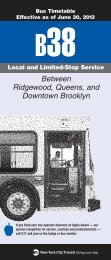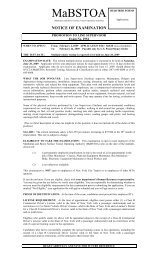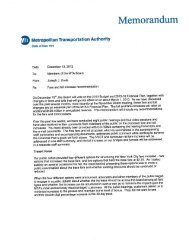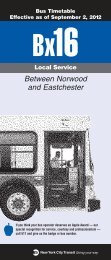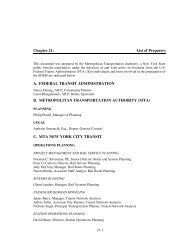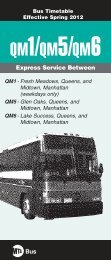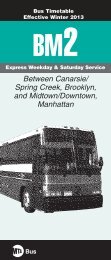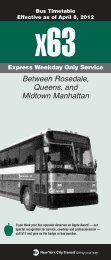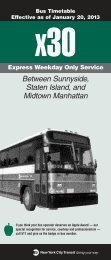Greening Mass Transit & Metro Regions: The Final Report - MTA
Greening Mass Transit & Metro Regions: The Final Report - MTA
Greening Mass Transit & Metro Regions: The Final Report - MTA
Create successful ePaper yourself
Turn your PDF publications into a flip-book with our unique Google optimized e-Paper software.
64<br />
Strategy for the 21st Century Legislative and Policy Recommendations<br />
This chapter outlines a sustainability action agenda for<br />
federal, state, regional, and local decision-makers. It identifies<br />
legislative and policy actions which the Commission<br />
believes will be necessary to assure the sustainability and<br />
future well-being of the <strong>MTA</strong> network and the New York<br />
metropolitan area. In addition to these recommendations,<br />
the Commission strongly supports the findings and recommendations<br />
of the Ravitch Commission, which will be critical<br />
to the financial viability of the <strong>MTA</strong> transit network. This<br />
Commission joins the Ravitch Commission in calling for<br />
significant increases in transit funding and investment.<br />
Such investments will be crucial if the New York metropolitan<br />
area is to retain its high levels of productivity and its<br />
position as a global economic power.<br />
At present, our national infrastructure investments lag far<br />
behind those of our global competitors. <strong>The</strong> United States<br />
is currently investing only 2.4 percent of GDP in major infrastructure<br />
initiatives, as compared to 5 percent in Europe and<br />
9 percent in China. 1 In addition to maintaining competitive<br />
advantage in the future, more robust transit funding will also<br />
help to stimulate the regional job growth and economic<br />
activity needed to meet the present financial crisis. David<br />
Lewis' initial assessment of the current recommendations<br />
FEDERAL GOVERNMENT’S ROLE<br />
described in this report indicate a possible yield of 105,500<br />
net new jobs per year, employment income of $5.1 billion a<br />
year, and regional economic output of $17 billion per year<br />
for the period from 2010 to 2019. <strong>The</strong>se figures reinforce<br />
recent economic analyses conducted by the <strong>MTA</strong> and the<br />
Port Authority of New York and New Jersey which indicate<br />
that every $1 billion in <strong>MTA</strong> capital spending generates an<br />
estimated 8,500 jobs, $440 million in total wages, and<br />
$1.5 billion in total sales or economic activity in New York<br />
and the surrounding region.<br />
<strong>The</strong> time to pursue this important agenda is now. We now<br />
have a clear convergence of priorities at every level of government.<br />
President Obama’s environmental commitments<br />
and his stated focus on infrastructure investment are<br />
matched by the strong environmental records and economic<br />
priorities of Governor Paterson, Governor Rell, and Mayor<br />
Bloomberg, creating an unprecedented opportunity to<br />
advance an ambitious sustainability agenda. <strong>The</strong><br />
Commission believes that the legislative and policy actions<br />
recommended in this chapter will not only strengthen and<br />
green the <strong>MTA</strong> system, they will have a positive, lasting<br />
impact on sustainability and economic recovery – regionally,<br />
nationally, and globally.<br />
1. Establish new funding sources for transit.<br />
• Pass a green infrastructure stimulus bill with a large allocation to mass transit and renewable energy projects.<br />
Investments should target 21st century transit and renewable energy projects in major metropolitan areas. Priority should<br />
be given to new projects that can demonstrate climate-stabilization benefits and high priority “state-of-good-repair”<br />
projects that extend the useful life of existing infrastructure, safeguarding these major public investments.<br />
• Pass a climate/energy bill establishing a market for carbon emissions avoidance, allocating at least 25 percent of auction<br />
revenues to transit. Institute rules to define carbon avoidance as a measurable, verifiable, and tradeable commodity. For<br />
the <strong>MTA</strong>, carbon avoidance results from: (1) avoided car trips through mode-shift from automobiles to transit; (2) reduced<br />
traffic congestion, which reduces tailpipe emissions from idling and stop-start traffic; and (3) denser land-use patterns,<br />
which shorten the distances and travel times between daily destinations.<br />
• Raise the federal gas tax by 40 cents over the next five years, index it to inflation and fund the transition to a mileagebased<br />
user fee. <strong>The</strong> federal gas tax should be increased 8 cents per gallon per year for the next five years and then be<br />
indexed to inflation. Although not a long-term solution based on a concerted effort to move away from carbon-based<br />
transportation solutions, gas tax revenues will remain a critically important transportation funding source for at least the<br />
next 10 years. Commit a portion of the new revenues to fully developing the technologies and policies that will enable the<br />
implementation of a mileage-based user fee.<br />
• Allow transportation projects to receive funding through other federal bills in areas such as housing and the environment.<br />
Align federal capital investments in housing and other infrastructure to compliment sustainable transportation goals and<br />
objectives.<br />
1 <strong>The</strong> Cracks are Showing, Economist, June 26, 2008.



